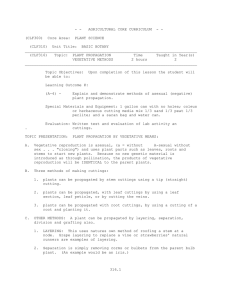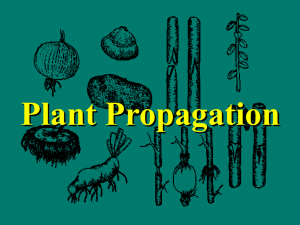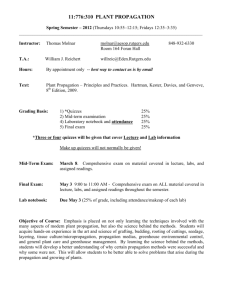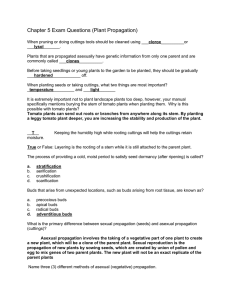PLSC 368: Plant Propagation
advertisement
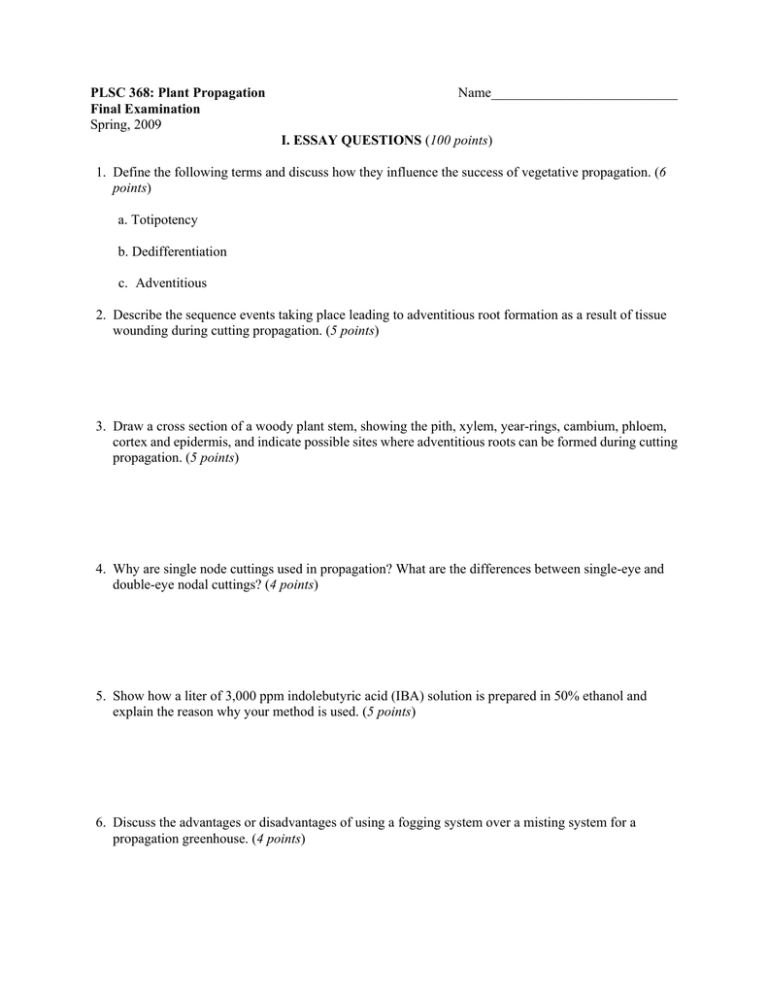
PLSC 368: Plant Propagation Final Examination Spring, 2009 Name___________________________ I. ESSAY QUESTIONS (100 points) 1. Define the following terms and discuss how they influence the success of vegetative propagation. (6 points) a. Totipotency b. Dedifferentiation c. Adventitious 2. Describe the sequence events taking place leading to adventitious root formation as a result of tissue wounding during cutting propagation. (5 points) 3. Draw a cross section of a woody plant stem, showing the pith, xylem, year-rings, cambium, phloem, cortex and epidermis, and indicate possible sites where adventitious roots can be formed during cutting propagation. (5 points) 4. Why are single node cuttings used in propagation? What are the differences between single-eye and double-eye nodal cuttings? (4 points) 5. Show how a liter of 3,000 ppm indolebutyric acid (IBA) solution is prepared in 50% ethanol and explain the reason why your method is used. (5 points) 6. Discuss the advantages or disadvantages of using a fogging system over a misting system for a propagation greenhouse. (4 points) 7. Root stocks used in grafting are often grown from seedling plants. Explain the reason why? (4 points) 8. Explain the procedures for the “toothpick” method of treating rooting hormone to woody plant cuttings. Include why such method is used in your discussion. (4 points) 9. Briefly describe why grafting is practiced for the following uses: (4 points) a. Clonal perpetuation b. Benefits of rootstock c. Changing cultivars of established plants d. Combining special forms in one plant 10. Explain the following methods of grafting with illustrations: (6 points) a. Bark graft b. Cleft graft c. Whip-and-tongue d. Bridge graft e. Inarching f. Side grafting 11. Describe the following methods of budding with drawings: (6 points) a. T-budding b. Inverted T-budding c. Chip budding d. Patch budding 2 12. Explain the following methods of layering with illustrations: (6 points) a. Tip layering b. Simple layering c. Trench layering d. Serpentine layering e. Mound layering f. Air layering 13. Describe the difference between monopodial and sympodial growth habits of orchids. (4 points) 14. Explain the difference between epiphytic orchids and terrestrial orchids with examples. (4 points) 15. Define the following specialized structures that are used for propagation with two plant examples. (6 points) a. Bulb b. Corm c. Rhizome d. Stolon e. Tuber f. Tuberous root 16. List and briefly explain four reasons why plants are propagated vegetatively (rather than sexually propagated). (4 points) 3 17. List all possible off-spring genotypes when a heterozygous plant for three known genes (AaBbCc) is self-pollinated. (5 points) 18. Define the following terms related to variability during clonal propagation. (6 points) a. Ramet b. Ortet c. Off-type d. True-to-type e. Genetic variation f. Epigenetic variation 19. Define the following terms used to describe phenotypic variation during clonal propagation. (6 points) a. Periphysis b. Cyclophysis c. Topophysis 20. Define “chimera” and describe the differences between the following chimeras with illustration. (6 points) a. Definition of chimera b. Periclinal chimera c. Mericlinal chimera d. Sectoral chimera 4 II. SHORT ANSWERS (30 points) 1. What is the difference between a phytohormone and a plant growth regulator? (3 points) __________________________________________________________________________________ __________________________________________________________________________________ __________________________________________________________________________________ 2. Contrast a tap root vs. an adventitious root: (3 points) __________________________________________________________________________________ __________________________________________________________________________________ __________________________________________________________________________________ 3. List four plants that can be propagated by root cutting: (3 points) a._______________ b._______________ c.________________ d._________________ 4. African violets can best be propagated by ________________ cuttings. (2 points) 5. Name the naturally produced phytohormones for: (2 points) Auxin: Cytokinin: ______________________________ ______________________________ 6. List three plants which can be propagated by leaf cuttings: (3 points) a. ____________________ b. ___________________ c. ________________________ 7. Describe the difference between a Aheel@ cutting and a Amallet@ cutting: (3 points) __________________________________________________________________________________ __________________________________________________________________________________ __________________________________________________________________________________ 8. What is a Atopworking@ and why is it used? (3 points) __________________________________________________________________________________ __________________________________________________________________________________ __________________________________________________________________________________ 9. How can you prove the fact that presence of buds on a stem stimulates root induction during cutting propagation? (3 points) __________________________________________________________________________________ __________________________________________________________________________________ __________________________________________________________________________________ 10. List three different groups of plant constituents that are usually translocated from leaves and the shoot apex to the root initiation site of a cutting during rooting: (3 points) a.______________________ b._____________________ c.______________________ 11. Why is stem girdling or etiolation helpful in stimulating root induction on stem cuttings? (20 points) __________________________________________________________________________________ __________________________________________________________________________________ __________________________________________________________________________________ 5 III. MULTIPLE CHOICES (20 points, 2 points each) 1. Adventitious shoots develop more readily from roots of mature plants than roots of juvenile plants. a. b. True False 2. Softwood cuttings are usually harvested during: a. b. c. d. the winter months. the dormant season. the fall season. the summer months. 3. Which of the following cannot be accomplished by treating cuttings with IBA during propagation? a. b. c. d. Increase percent cuttings rooting Early induction of rooting Increase number of roots per cutting Prevent development of root diseases 4. During cutting propagation, the quality of root system produced can be enhanced by fertilizer application. a. b. True False 5. The variegated sansevieria (Sansevieria trifasciata laurentii) is not propagated by leaf cuttings because the regenerated plants become non-variegated. a. True b. False 6. An interstock can be used in grafting to: a. b. c. d. induce disease resistance. increase plant height. overcome incompatibility between scion and rootstock. change flower sex expression. 7. Which of the following orchids produces backbulbs? a. b. c. d. Epidendron Cattleya Cypripedium Cymbidium 8. Sympodial growth habit is found in: a. b. c. d. Vanda orchids. Cymbidium orchids Dendrobium orchids Cattleya orchids. 6 9. Which of the following is most likely the reason why seedling grafting is widely practiced for watermelon production in Asia? a. b. c. d. Larger fruit sizes Earlier marketing of fruits Tolerance of the rootstock (wild gourd) to soil-borne diseases Higher fruit sugar content 10. Which of the following histogenic layers in the meristem would eventually give rise to gametes (pollen, ovule)? a. b. c. d. Layer 1 Layer 2 Layer 3 Layer 4 (corpus) BONUS QUESTION (3 points) Make your own question from subjects that you have studied but were not covered in this exam and answer it correctly. Honor Pledge: Upon my honor I have neither given nor received aid in writing this exam. Signed________________________________ 7

